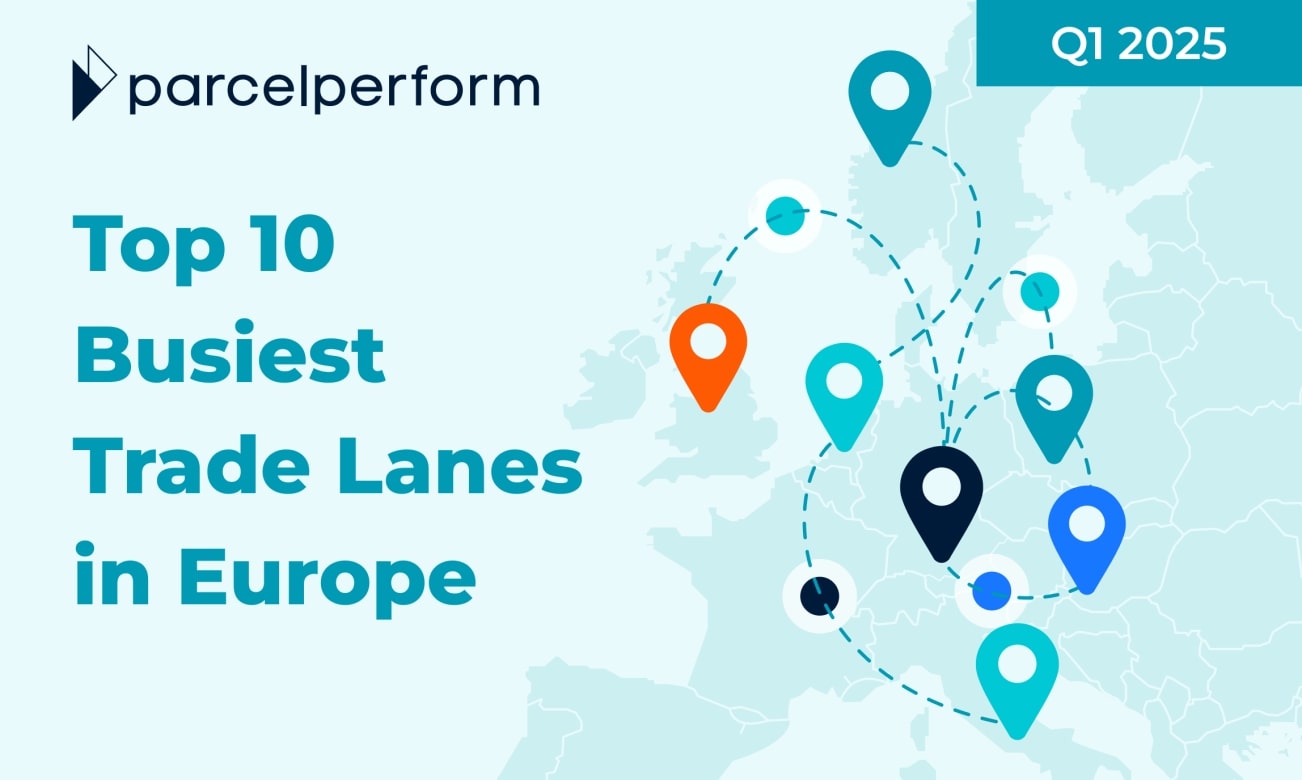Top 10 busiest trade lanes in Europe in Q1 2025
Written by
Editorial TeamPublished on
Europe’s e-commerce boom, projected to reach $961.27 billion by 2029, is driving unprecedented demand for efficient trade lanes across the continent. Parcel Perform’s Q1 2025 analysis highlights the top 10 busiest domestic and cross-border trade routes, uncovering transit times, delivery performance, and the power of data-driven logistics. (Ad)

Commercial collaboration
From Berlin to Barcelona, internet shopping transforms how Europeans interact with products, brands, and technology. By 2025, e-commerce revenue in Europe is predicted to exceed $707.87 billion and hit a new high of $961.27 billion in 2029. Meanwhile, Europe’s e-commerce user base is estimated to reach 446 million by 2029. With 92% of Europe’s population online, businesses must improve their logistics operations to enable seamless cross-border and domestic shipments.
Trade lanes are critical to the efficiency and dependability of the e-commerce logistics business, particularly in a continent as interconnected as Europe. As customer demand for rapid, economical delivery grows, well-established trade lanes allow e-commerce companies to transport items across borders quickly.
This article is part of Parcel Perform’s Busiest Trade Lanes series, highlighting Europe’s top 10 busiest trade routes for Q1 2025. Furthermore, it seeks to give critical insights into transit times, delivery performance, logistical difficulties, and potential solutions.
What are trade lanes?
A trade lane (or trade route) is a specialized pathway that transports commodities between two or more locations, usually across international borders. They are crucial to supply chain management because they control the flow of products from manufacturing to consumption. Understanding trade lanes enables logistics experts to optimize transit routes, choose suitable carriers, and successfully coordinate logistics tasks.
Domestic trade lanes operate within a single country, enabling enterprises to fulfill orders swiftly and meet customer demands. In addition, these routes allow businesses to transport goods between warehouses and distribution hubs while ensuring quick delivery times for local shipments.
On the other hand, cross-border trade routes connect two or more countries. These routes help promote international business by making it easier to transfer goods across borders. However, these routes need thorough planning to avoid customs procedures, fees, and shipping difficulties.
Top 5 busiest domestic trade lanes in Europe
UK – UK: United Kingdom to United Kingdom
In Q1 2025, the United Kingdom maintained its position as one of Europe’s top e-commerce markets, supported by strong domestic trade lane performance. It remains highly logistically efficient with an average transit time of 1.24 days and a 98.74% on-time delivery rate. What’s more, nationwide fulfillment centers and infrastructure improvements, such as the A4545 motorway, have reduced delays, while major carriers like Royal Mail and DPD UK ensure smooth, reliable deliveries across the country.
DE – DE: Germany to Germany
The domestic trade network of Germany is still one of Europe’s most advanced. It facilitates a wide range of shipments throughout the country. In the first quarter, logistics providers reported an average transit time of 1.34 days and a 97.42% on-time ratio. Importantly, infrastructure developments, such as the upgrading of the Riedbahn route between Frankfurt and Mannheim, have increased freight speed and dependability. Whereas, major carriers like DHL and Hermes contribute to seamless and efficient deliveries.
IT – IT: Italy to Italy
Domestic shipping in Italy had an average travel time of 1.52 days in Q1 2025, with an 82.42% first-time delivery success rate. The 15-km expansion of the Pedemontana-Piemontese route in Piedmont has improved parcel flow and reduced congestion in northern Italy. These changes promote logistical expansion by allowing for speedier delivery times. Despite that, more work must be done to guarantee that items are delivered to clients on the first attempt.
NL – NL: Netherlands to Netherlands
The Netherlands is an important logistics center in Europe, which is also renowned for its excellent transportation infrastructure. In Q1 2025, domestic trade lanes had an average transit time of 1.31 days and an 82.82% first-time delivery success rate. Infrastructure upgrades, such as the A27 highway upgrade near Utrecht, have helped alleviate delays. Meanwhile, key logistics companies such as PostNL, DHL, and DPD ensure that parcels are delivered reliably and smoothly across the country.
AT – AT: Austria to Austria
Austria’s key location in Central Europe necessitates the use of domestic trade lanes for national and regional distribution. In the first quarter, the nation’s domestic shipping market had an average travel time of 1.36 days and a first-attempt delivery success rate of 80.17%. Fortunately, minor improvements to the A14 near Bregenz reduced congestion and improved transit times for this significant domestic freight route. Austrian Post, DPD Austria, UPS, and GLS Austria are among the major logistics providers that provide timely delivery throughout the country.
Top 5 busiest cross-border trade lanes in Europe
DE – AT: Germany to Austria
Germany and Austria continue to retain one of Europe’s most important cross-border trade lanes, although the first quarter of 2025 saw significant interruption. The average transit time increased to 2.21 days, with a 78.05% success rate on the first delivery attempts. What’s more, a foot-and-mouth disease outbreak in neighboring areas triggered border closures and restrictions, resulting in delays and rerouting. Despite these hurdles, carriers such as DHL, DPD Austria, and UPS are still attempting to enhance delivery performance.
DE – NL: Germany to Netherlands
Germany and the Netherlands are two of Europe’s major economies. These countries have a robust trading partnership reinforced by EU single-market policy. In the first quarter of 2025, cross-border shipments between the two nations had an average transit time of 1.53 days and an 82.13% first-time delivery success rate. Although performance has remained stable, continued customs challenges and new Dutch laws on freelance labor have hampered delivery efficiency. Despite these problems, leading logistics providers remain committed to seamless logistics.
UK – AU: United Kingdom to Australia
The shipping route connecting the United Kingdom and Australia is critical for trade between Europe and the Asia-Pacific region. In the first quarter, logistics providers had a remarkable average transit time of 4.36 days, with a 98.41% on-time delivery rate. DHL’s Paperless Trade system and Australia Post’s 800+ Parcel Locker locations have improved logistics, decreasing delays during customs clearance and last-mile delivery.
DE – IT: Germany to Italy
Germany and Italy both depend on well-developed road and rail networks to maintain smooth commerce flows. In the first quarter of 2025, the average transit time was 2.69 days, with a 96.9% on-time ratio. Efficient infrastructure, such as the A9 and Autostrada A22 across Austria, enables timely shipping. Notably, major carriers such as DHL, GLS Italy, UPS, and Poste Italiane contribute to ensuring dependable cross-border delivery.
UK – US: United Kingdom to United States
As two of the world’s major e-commerce markets, the strong partnership between the UK and the US generates billions of dollars in annual trade. In Q1 2025, shipping providers reported an average travel time of 4.55 days and a 93.66% on-time delivery ratio. Furthermore, the collection point usage ratio stood at 11.96%, with significant last-mile delivery assisting delivery. Leading carriers, like DHL, FedEx, UPS, and USPS, guarantee that logistical operations run efficiently.
How to address delivery problems in domestic and cross-border shipping?
The Q1 2025 trade lane performance analysis highlights key challenges that e-commerce and logistics providers must address to maintain efficiency and improve delivery reliability. Below are 3 major issues and how data-driven logistics solutions can help overcome them.
- Customs delays and border restrictions
Customs concerns and new regulations caused delays in cross-border commerce channels from Germany to Austria and from Germany to the Netherlands. Meanwhile, the Netherlands faced stiffer rules on freelance workers, which hampered delivery efficiency.
To solve these issues, businesses may use automated documentation tools and AI-powered cargo tracking systems to anticipate future interruptions. Innovative data solutions may also help enterprises to comply with regulations faster and guarantee smoother cross-border transactions.
- Traffic and transit congestion
Despite road upgrades, traffic congestion continues to cause delivery delays in countries like Italy and the Netherlands. Even routes with improved infrastructure, such as Germany to Italy, face challenges.
Logistics providers can tackle these issues using AI-powered traffic analytics for real-time rerouting and smarter planning to distribute shipments across multiple fulfillment centers.
- Failed first-attempt deliveries
Domestic trade lanes in Italy, Austria, and the Netherlands reported low first-attempt delivery success rates, indicating that many shipments did not reach customers on the first try. These missed deliveries lead to delays and increased costs.
To improve outcomes, businesses can implement smart collection points, flexible pickup options, and AI-powered notifications with predictive delivery scheduling to boost efficiency.
Optimizing e-commerce logistics in Europe with data-driven strategies
The Q1 2025 analysis of Europe’s busiest trade lanes reveals progress and ongoing domestic and cross-border shipping challenges. While countries like the UK, Germany, and the Netherlands benefit from strong logistics networks, customs delays, traffic congestion, and missed deliveries still disrupt key routes.
With that in mind, as e-commerce expands, businesses must adopt innovative, data-driven logistics solutions to enhance delivery performance. Tools like Parcel Perform’s real-time insights can help reduce disruptions and boost shipping reliability across Europe.
Are you ready to harness the power of real-time analytics for your business? Book a demo with Parcel Perform to explore how this platform may help you flourish in current times.
***


